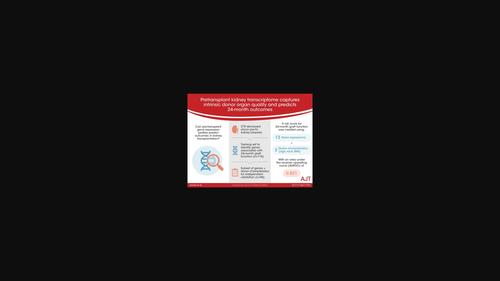当前位置:
X-MOL 学术
›
Am. J. Transplant.
›
论文详情
Our official English website, www.x-mol.net, welcomes your feedback! (Note: you will need to create a separate account there.)
Pretransplant kidney transcriptome captures intrinsic donor organ quality and predicts 24-month outcomes
American Journal of Transplantation ( IF 8.8 ) Pub Date : 2022-06-22 , DOI: 10.1111/ajt.17127 Kellie J Archer 1 , Elissa Bardhi 2 , Daniel G Maluf 3, 4 , Jennifer McDaniels 2 , Thomas Rousselle 2 , Anne King 5 , James D Eason 6 , Lorenzo Gallon 7 , Enver Akalin 8 , Thomas F Mueller 9 , Valeria R Mas 2
American Journal of Transplantation ( IF 8.8 ) Pub Date : 2022-06-22 , DOI: 10.1111/ajt.17127 Kellie J Archer 1 , Elissa Bardhi 2 , Daniel G Maluf 3, 4 , Jennifer McDaniels 2 , Thomas Rousselle 2 , Anne King 5 , James D Eason 6 , Lorenzo Gallon 7 , Enver Akalin 8 , Thomas F Mueller 9 , Valeria R Mas 2
Affiliation

|
With the development of novel prognostic tools derived from omics technologies, transplant medicine is entering the era of precision medicine. Currently, there are no established predictive biomarkers for posttransplant kidney function. A total of 270 deceased donor pretransplant kidney biopsies were collected and posttransplant function was prospectively monitored. This study first assessed the utility of pretransplant gene expression profiles in predicting 24-month outcomes in a training set (n = 174). Nearly 600 differentially expressed genes were associated with 24-month graft function. Grafts that progressed to low function at 24 months exhibited upregulated immune responses and downregulated metabolic processes at pretransplantation. Using penalized logistic regression modeling, a 55 gene model area under the receiver operating curve (AUROC) for 24-month graft function was 0.994. Gene expression for a subset of candidate genes was then measured in an independent set of pretransplant biopsies (n = 96) using quantitative polymerase chain reaction. The AUROC when using 13 genes with three donor characteristics (age, race, body mass index) was 0.821. Subsequently, a risk score was calculated using this combination for each patient in the validation cohort, demonstrating the translational feasibility of using gene markers as prognostic tools. These findings support the potential of pretransplant transcriptomic biomarkers as novel instruments for improving posttransplant outcome predictions and associated management.
中文翻译:

移植前肾脏转录组捕获内在供体器官质量并预测 24 个月的结果
随着源自组学技术的新型预后工具的发展,移植医学正在进入精准医学时代。目前,还没有确定的移植后肾功能预测生物标志物。共收集了 270 例已故供体移植前肾脏活检样本,并对移植后功能进行了前瞻性监测。这项研究首先评估了移植前基因表达谱在预测训练集 24 个月结果中的效用 ( n = 174)。近 600 个差异表达基因与 24 个月的移植物功能相关。在 24 个月时进展为低功能的移植物在移植前表现出上调的免疫反应和下调的代谢过程。使用惩罚逻辑回归模型,24 个月移植物功能的接受者操作曲线 (AUROC) 下的 55 个基因模型面积为 0.994。然后在一组独立的移植前活组织检查中测量候选基因子集的基因表达(n = 96) 使用定量聚合酶链反应。使用具有三个供体特征(年龄、种族、体重指数)的 13 个基因时,AUROC 为 0.821。随后,使用该组合为验证队列中的每位患者计算风险评分,证明使用基因标记作为预后工具的转化可行性。这些发现支持移植前转录组生物标志物作为改进移植后结果预测和相关管理的新工具的潜力。
更新日期:2022-06-22
中文翻译:

移植前肾脏转录组捕获内在供体器官质量并预测 24 个月的结果
随着源自组学技术的新型预后工具的发展,移植医学正在进入精准医学时代。目前,还没有确定的移植后肾功能预测生物标志物。共收集了 270 例已故供体移植前肾脏活检样本,并对移植后功能进行了前瞻性监测。这项研究首先评估了移植前基因表达谱在预测训练集 24 个月结果中的效用 ( n = 174)。近 600 个差异表达基因与 24 个月的移植物功能相关。在 24 个月时进展为低功能的移植物在移植前表现出上调的免疫反应和下调的代谢过程。使用惩罚逻辑回归模型,24 个月移植物功能的接受者操作曲线 (AUROC) 下的 55 个基因模型面积为 0.994。然后在一组独立的移植前活组织检查中测量候选基因子集的基因表达(n = 96) 使用定量聚合酶链反应。使用具有三个供体特征(年龄、种族、体重指数)的 13 个基因时,AUROC 为 0.821。随后,使用该组合为验证队列中的每位患者计算风险评分,证明使用基因标记作为预后工具的转化可行性。这些发现支持移植前转录组生物标志物作为改进移植后结果预测和相关管理的新工具的潜力。



























 京公网安备 11010802027423号
京公网安备 11010802027423号